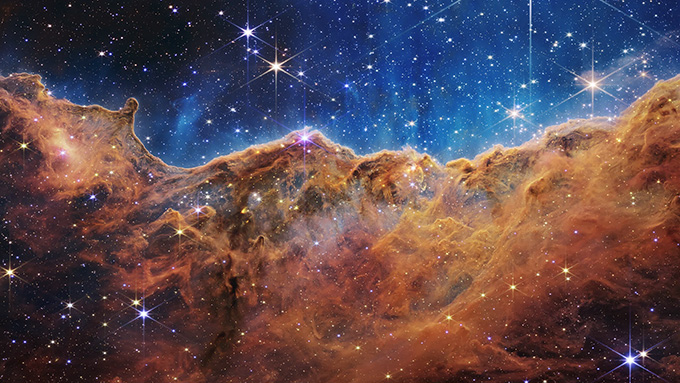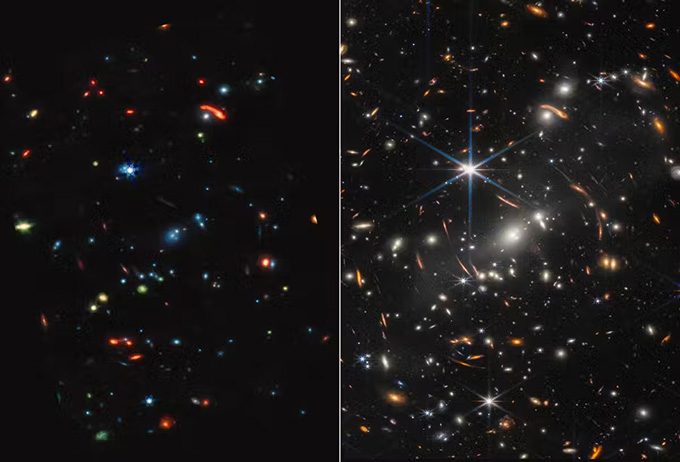
A spectacular image from the James Webb Space Telescope (JWST) of the deep Universe, the closest view yet of its origins in the Big Bang, shows a much higher density of galaxies than expected. Such a cluster of galaxies at the origins of the Universe is theoretically impossible unless we assume that the formation and early evolution of stars and galaxies occurred much earlier than previously thought, or that the Universe is much, much older, millions of years older than we thought.

The galaxy cluster SMACS 0723 as seen in mid-infrared light by NASA’s James Webb Space Telescope. At right, the James Webb near-infrared image. NASA, ESA, CSA, STScI , CC BY
Observations with the James Webb Space Telescope have revealed massive, bright galaxies with incomprehensible evolution in a Universe estimated to be about 13.8 billion years old ( or Giga years, Ga ), according to the standard Lambda-CDM (ΛCDM Cosmological Constant Cold Dark Matter ) model. The galaxies discovered would have to be much older than the Universe itself.
These intriguing discoveries force us to revisit something fundamental: how we count cosmic years.
The age of the stars.
From minimum to maximum, if we know the age of the oldest stars, we have a reference for the age of the entire galaxy, and if we know the age of many galaxies, we can have a reference for the total age of the Universe. But this is so important that we have to be very careful about the methods we use.
Nucleocosmochronology has been used , for example, to discover the age of the Sun (4.57 ± 0.02 billion years) and the Milky Way, but also to discover which were the first stars .
The method is based on measuring the amount of thorium (232Th) and uranium (238U) that stars have had time to produce. It is also possible to find out what phase they are in by calculating the amount of fuel (hydrogen) they have consumed and how much they have left to leave the main sequence, the initial phase of their life.
We know this because they change color. Stars that are chromatically above a certain level of blue (known as the turnoff point ) will have already left the main sequence, becoming redder and increasing in size, while redder and smaller stars are still young.
Knowing the age of many stars, we can deduce the age of globular clusters. Now, if the age of the Universe is estimated at 13.8 Ga, we have to deduce the time between the Big Bang and the formation of the cluster and take into account a minimum time spent in its formation. With all this, the age of the oldest clusters should not exceed 13.6 Ga.
The universal age
To date, data from multiple experiments have not been aggregated into a single model capable of providing a global, universal age scale across the entire time domain. Nor is there a systematic and robust cross-calibration that compares the values obtained between the various methods used. Therefore, it is a real challenge to establish the age limit of objects in the Cosmos, that is, to find the maximum number of years since they were formed.
This presents a huge challenge for constraining the ages of objects in the Universe. With the new data from James Webb, we had no choice but to start from scratch, without regard to the limits we had set. We had to look again, realizing that clusters, galaxies and the entire Universe may be much older than conventional physics had assumed.
And that’s what we did: we investigated globular clusters without taking into account the lower age limit that had been set for them. And we have new evidence that the Universe is “older” than we thought.
Age or appearance of age
Research by Rajendra P. Gupta of the University of Ottawa, Canada, has already raised the alarm. His work doubles the current age of the Universe. Gupta reports that it must be 26.7 Ga, twice as old as we thought.
This result explains the existence and formation of massive galaxies when the universe was theoretically still young. Gupta’s results resolve the dilemma presented by the James Webb Space Telescope’s image of the deep universe.
The abundance of blue stars
Our work provides further evidence in favor of an older Universe. We have developed a more objective method for determining the age of globular clusters based on the abundance of blue stragglers ( BSs ). Blue stragglers are stars that appear to be younger than the age of the star system to which they belong. No attempt has ever been made to infer the ages of globular clusters using this method.
In our work, we show that the emergence and/or formation of straggler stars begins at the origin of the cluster. This implies that the number of BS stars serves as an indicator of the cluster age.
We found that some clusters had ages between 14.7 and 21.6 Ga, inferring a Universe with an age of around 26 Ga, very close to the 26.7 Ga value deduced by the Gupta model.
The developed method was reported in the American Journal of Astronomy and Astrophysics .
No need for dark matter
There are other studies that align with our result, such as the one that found that the ages of some very old metal-poor stars range from 13.3 Ga to 16.0 Ga.
But our results go further: it is possible to explain the presence of primitive massive galaxies, very old globular clusters and very old stars without the need to take dark matter into account.
All of this reinforces the need for a critical review of the models that predict the existence of dark matter and dark energy, as well as of the already established models on the dynamics of the Universe.
We need to create new models that fit and respond to what we are observing.
Author Bio: Felix Llorente de Andres is a Researcher at the Astrobiology Center (INTA-CSIC)
